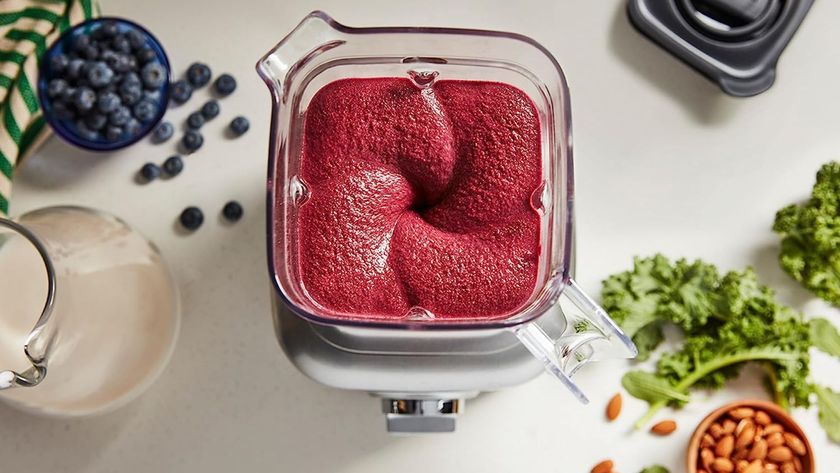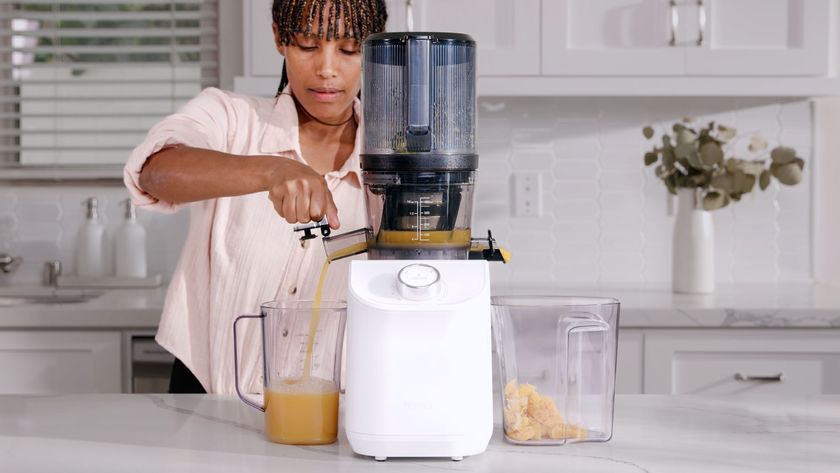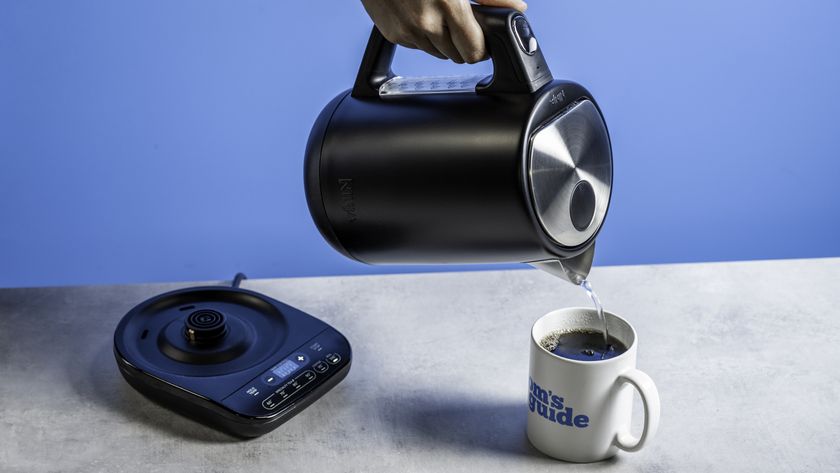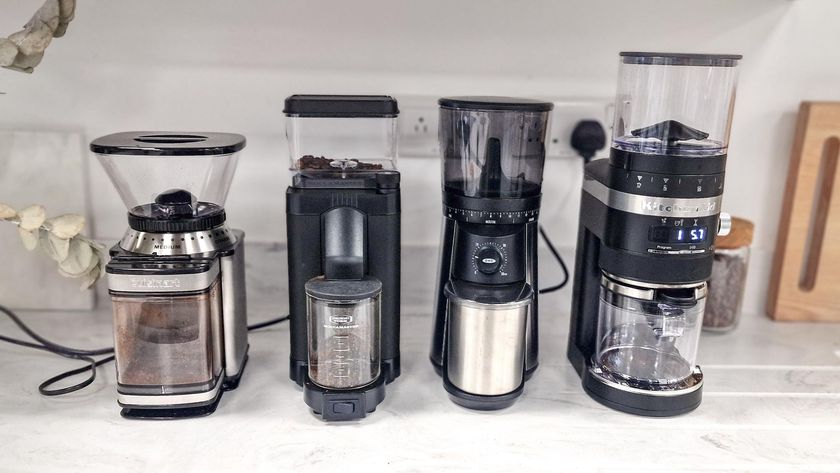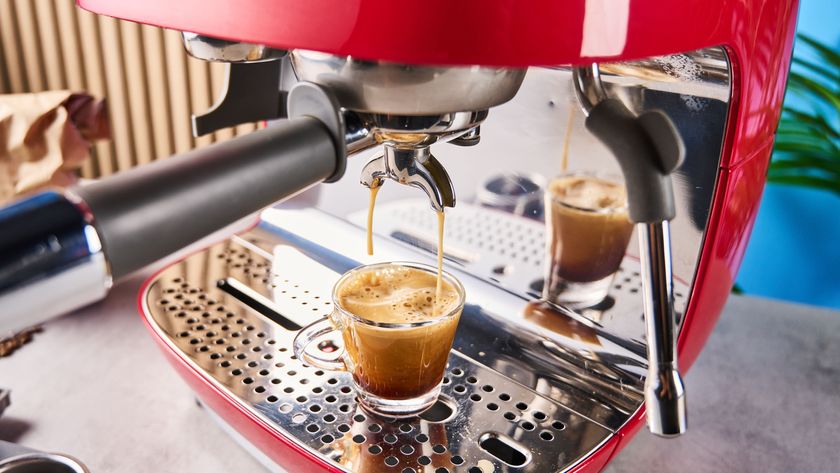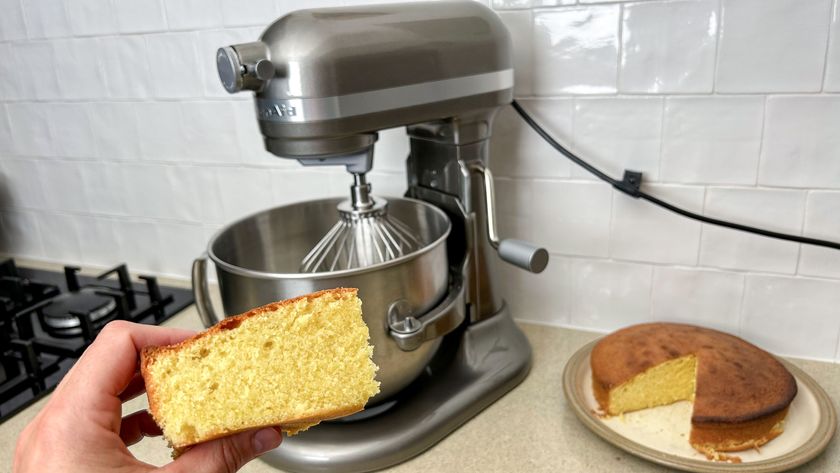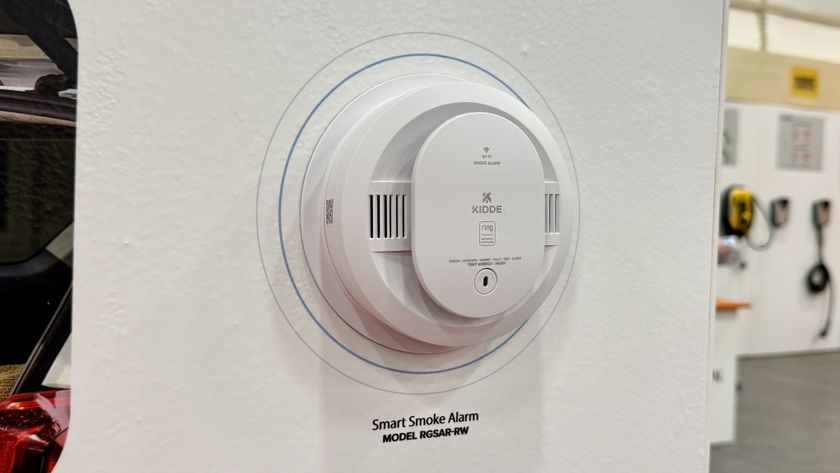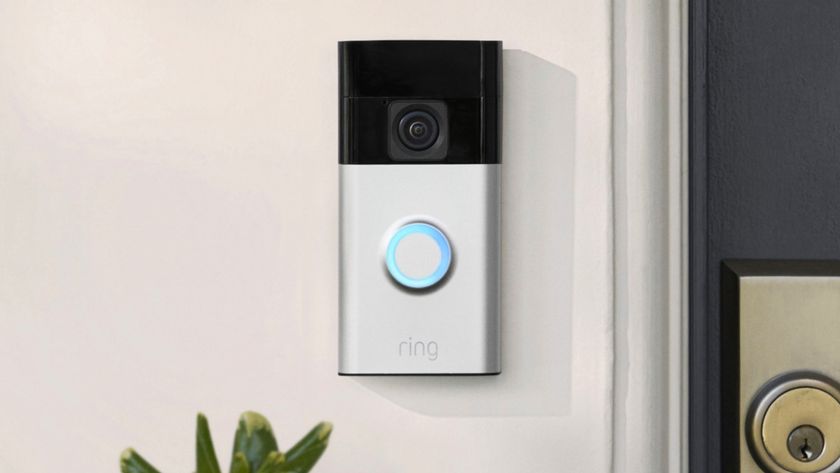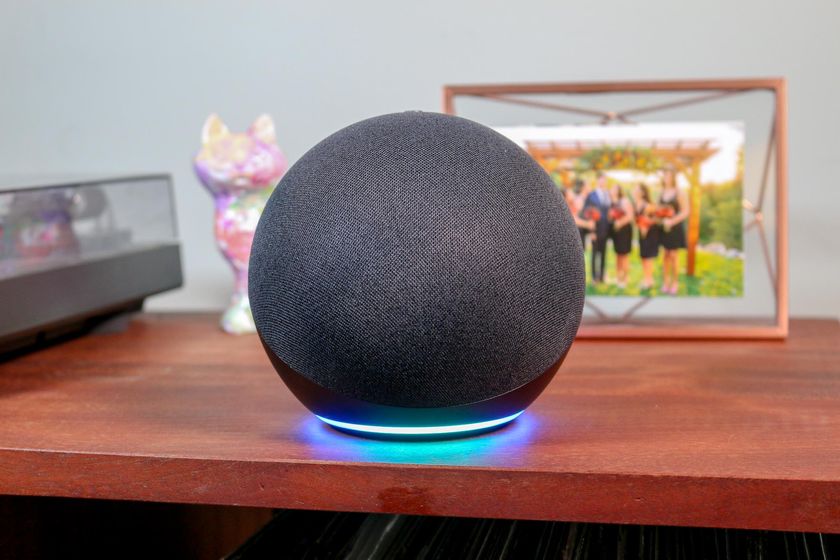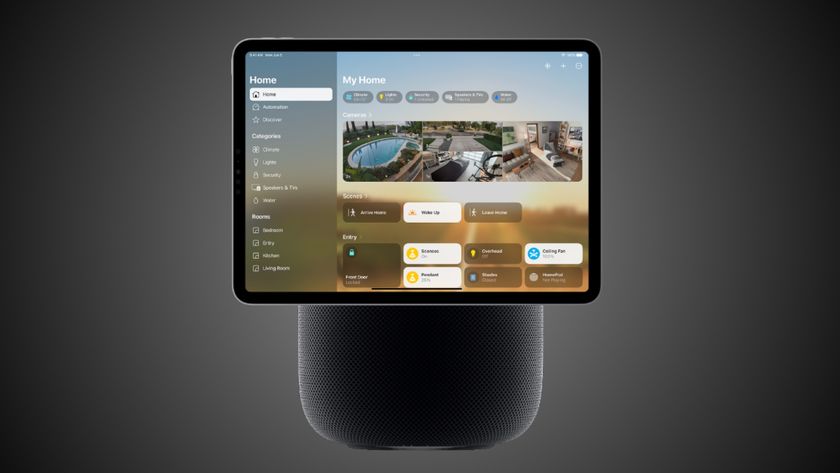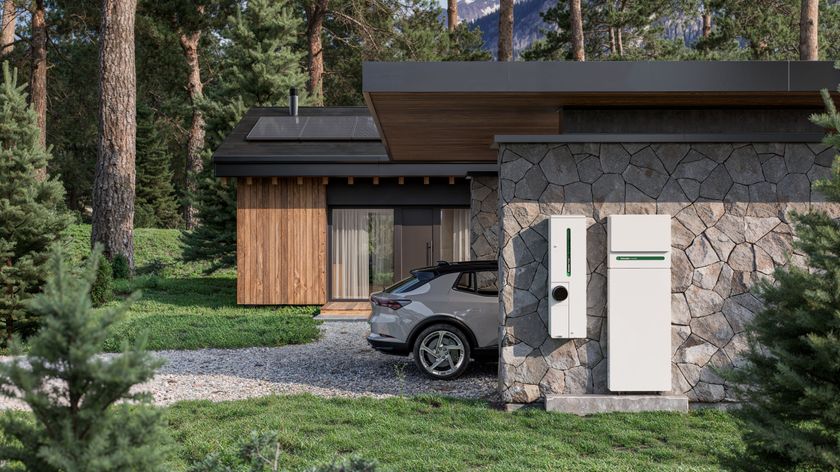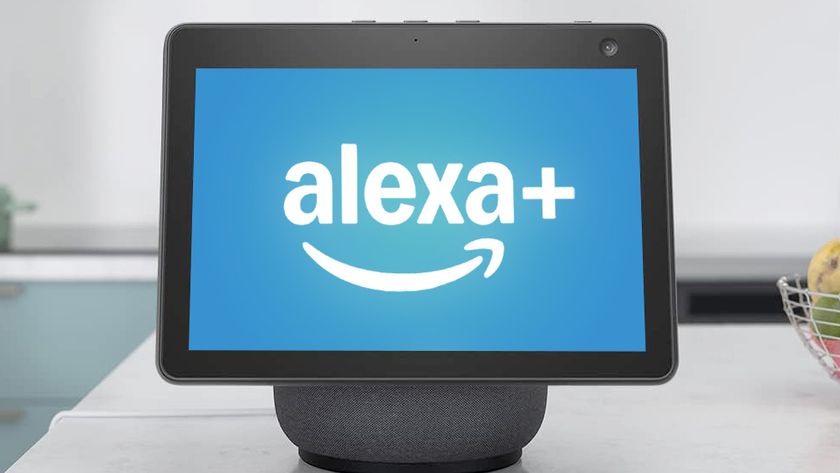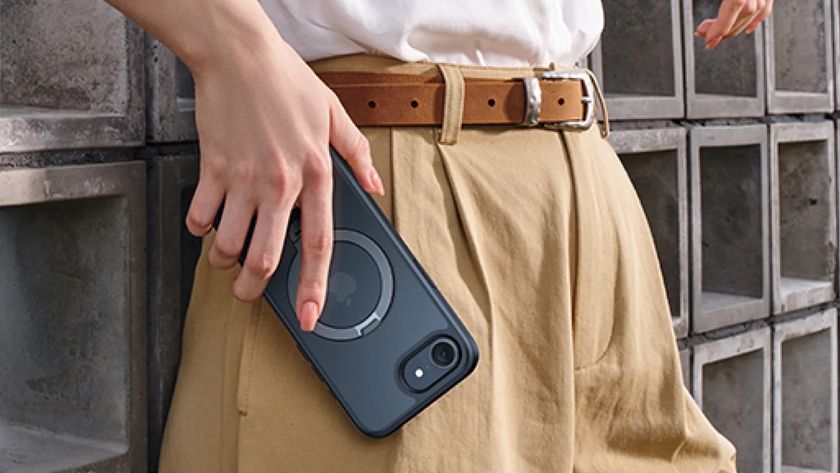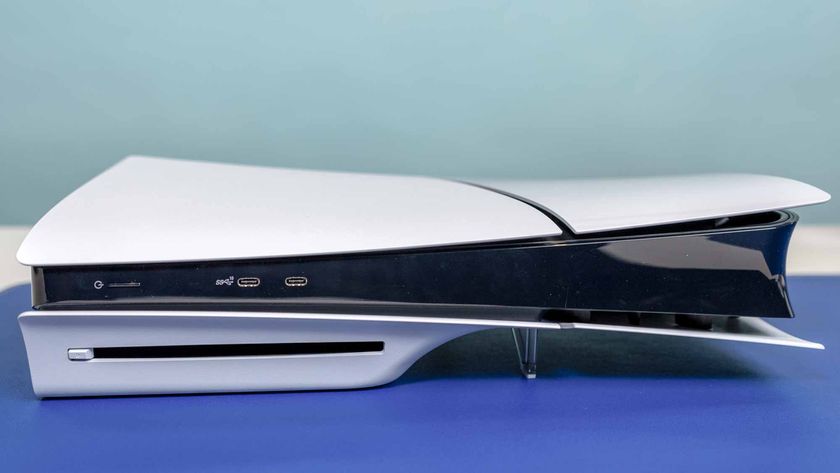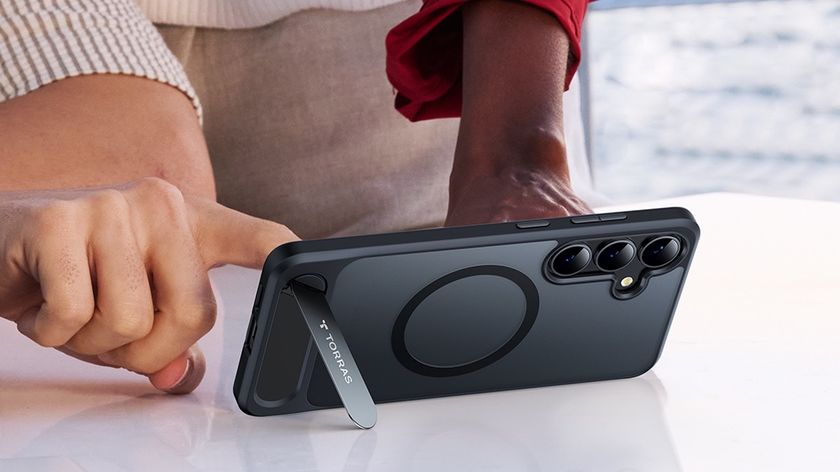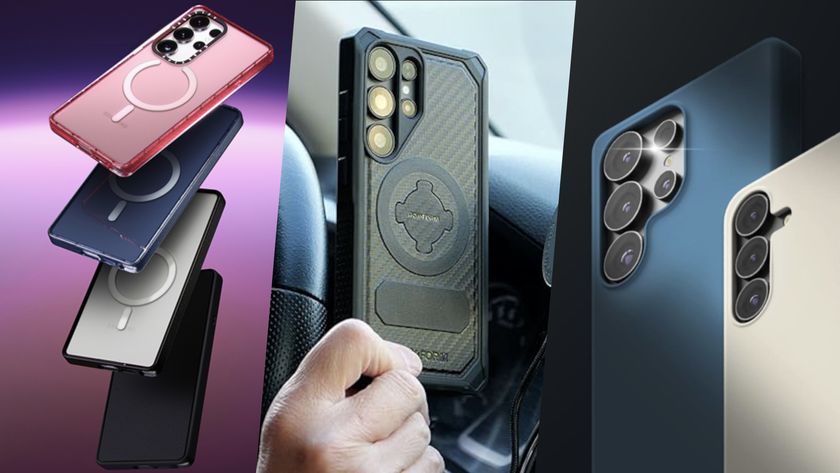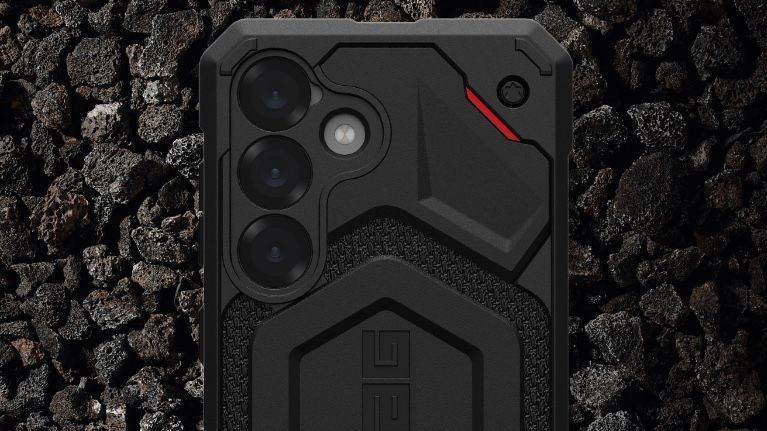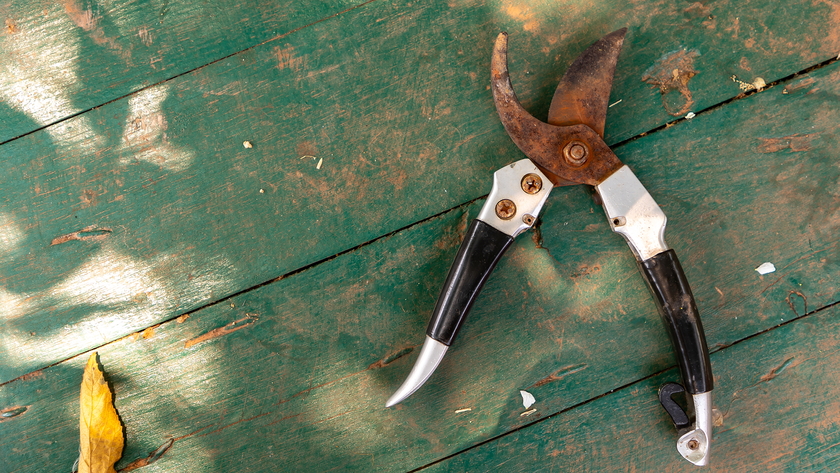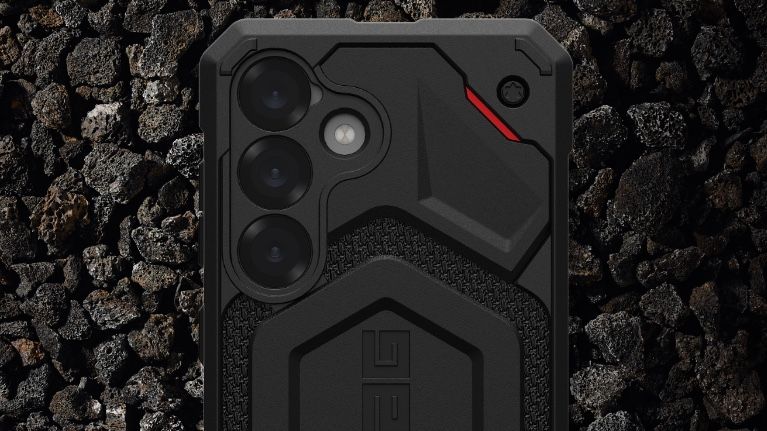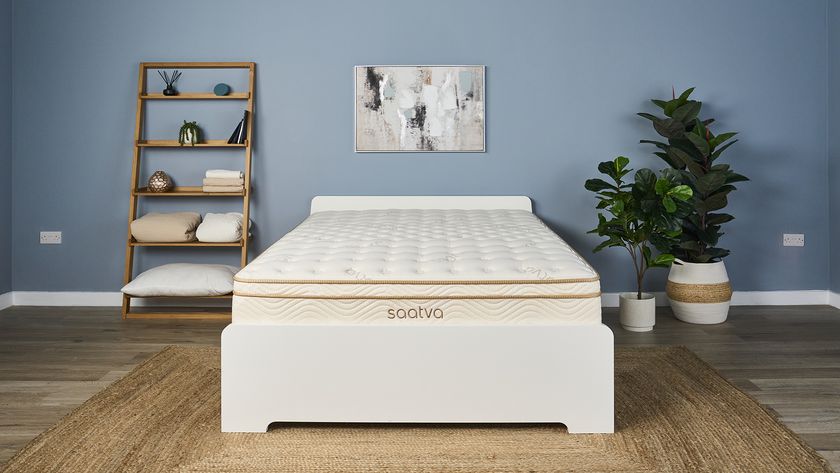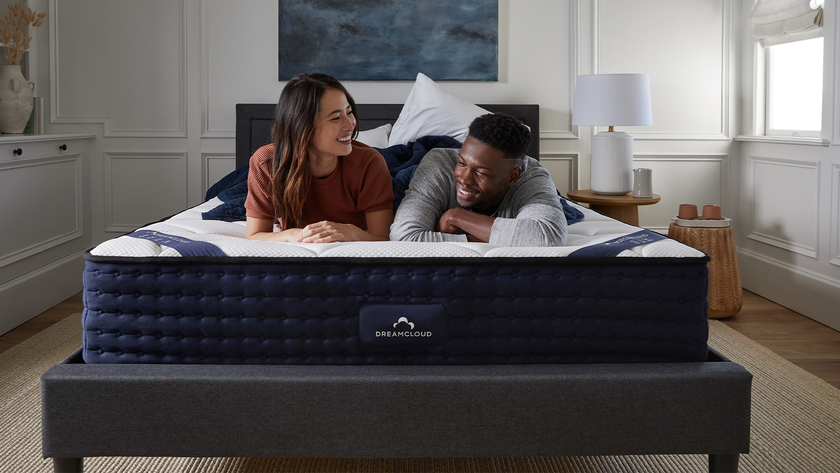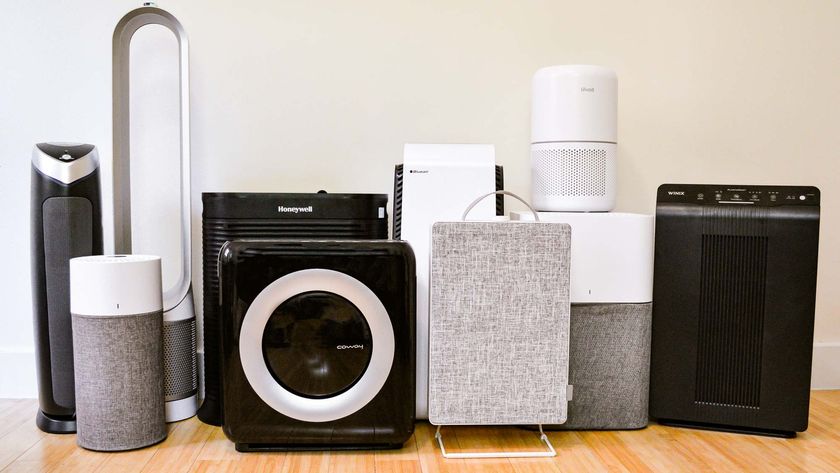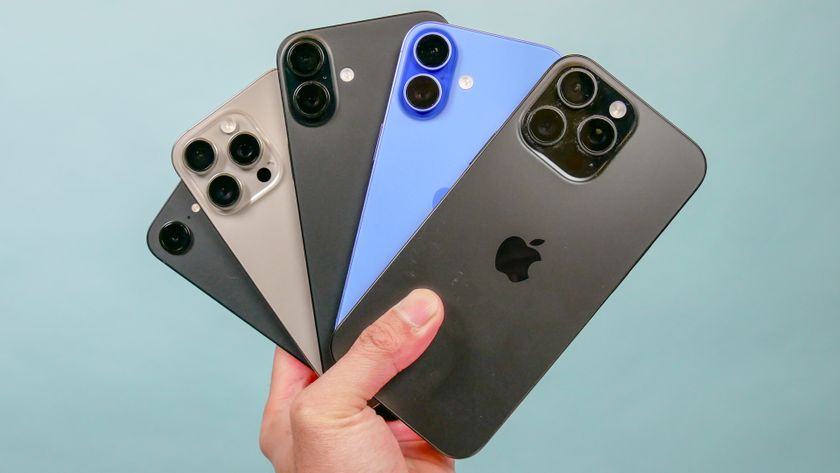Best juicers
We tested the best juicers for every use and budget, featuring masticating and centrifugal models from Hurom, Tribest, Omega and more.
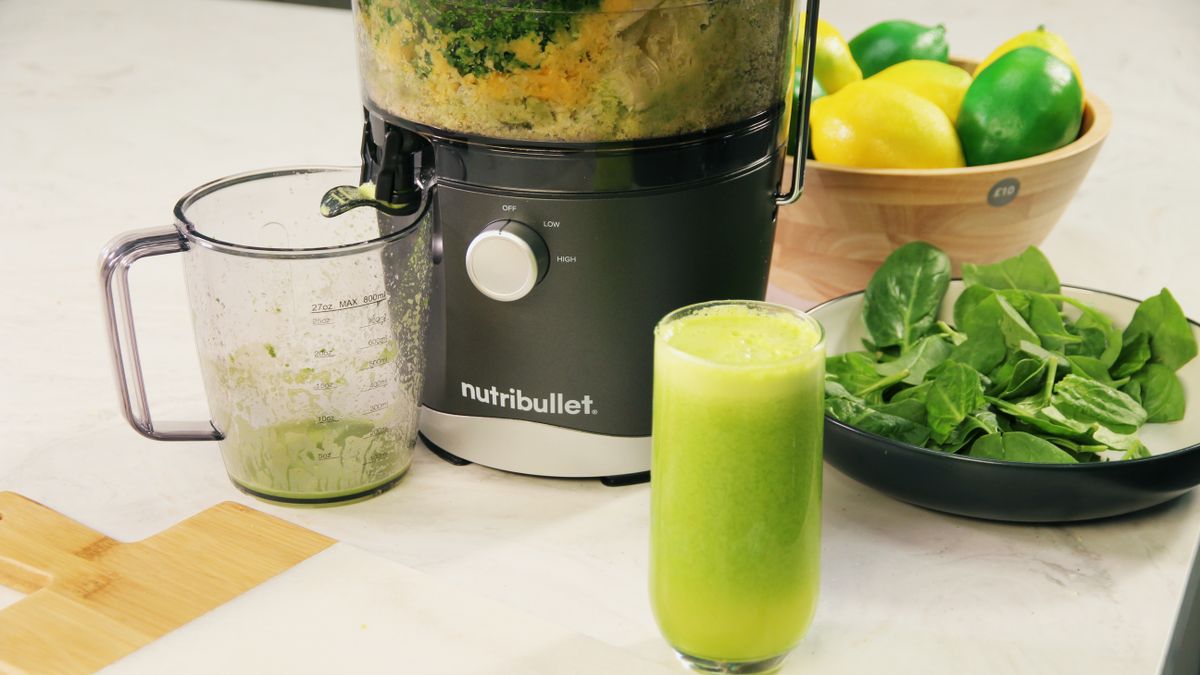
Opting for one of the best juicers is a surefire way to boost your vegetable and fruit intake. Extracting vitamin-dense, fibrous drinks from a plate of produce, many people turn to these juicers to create zingy shots to wake them (and their digestive system) up for the morning, as well as making plant-based milks and even desserts.
Choosing the best juicer for you will depend on your preferences. Firstly, there are two main types of juicers to choose from. Centrifugal juicers harness the same tech as the best blenders to shred fruits and vegetables before separating the solids from the liquids, which will result is a less fibrous drink that's often smoother, and more similar to the store-bought equivalent. Alternatively, a cold press or masticating juicer will mimic a chewing motion to extract juice and fiber without damaging the nutritional content of your produce through heat and fast blades. These juicers are often more expensive, but they're definitely the healthiest choice.
We've tested dozens of market-leading juicers, whittling them down to a best juicer guide that will have the right option for every user, on any budget. When reviewing all of these juicers we looked for the yield per gram of produce we tested, and also considered how easy they were to clean and how successfully they tackles a range of ingredients. Here are our top picks.
The quick list
Here’s the best juicers you can buy right now based on our testing and reviews. Scroll on for our full in-depth reviews.
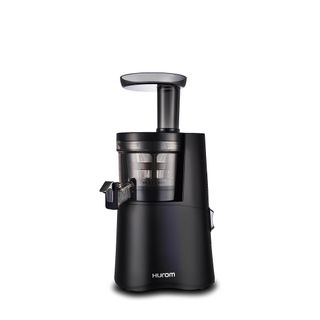
This Hurom masticating juicer consistently achieved high yields of juice, whether facing oranges, apples or berries. We found it to be incredibly efficient, and for a cold press juicer, not too fussy. This versatile machine can also be used to make ice cream, nut milks and tofu.
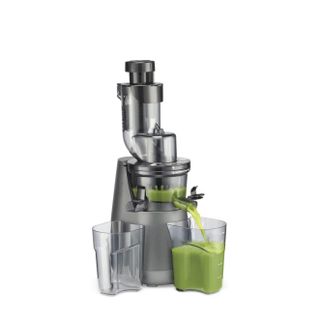
This Cuisinart juicer offered a great performance for an affordable price. It’s compact with an upright design, and achieves a high juice yield, particularly for beets, blueberries and strawberry juice. It also features a reverse function, which came in particularly helpful when cleaning.
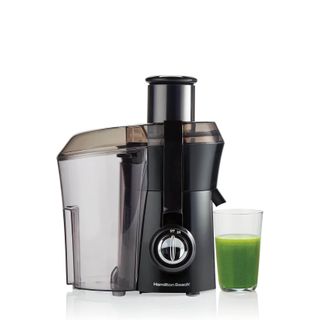
This Hamilton Beach juicer scored consistently across the board, making it our top pick of the centrifugal juicers we tested. It’s lightweight, compact and easy to use with a wide 3-inch chute. Plus, it achieved impressive juice yield results for a centrifugal design, and it's pretty affordable, too.

The Nama J3 is the most user-friendly model we tried when testing famously fiddly masticating juicers. A smaller and more portable version of Nama's iconic J2, the J3 slots neatly into smaller kitchens and is easy to use and clean. We particularly enjoyed the hands-free juicing chamber which allows you to add your ingredients all in one go.
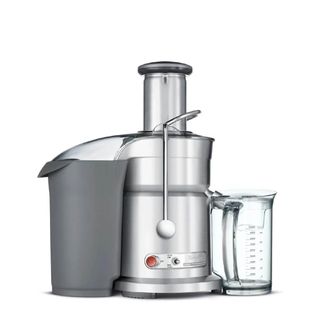
For bulk juicing, the Breville Juice Fountain Elite is our top pick. It comes with two speeds for added control, and it can hold up to 1.1 quarts of juice at a time. With 1000 watts of power, we found that it can handle tough produce such as carrots and kale with ease.
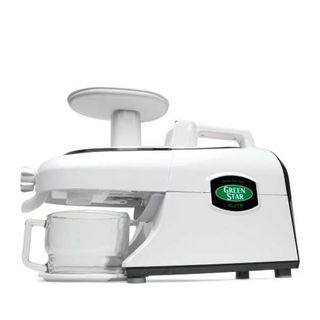
Twin-gears allow for the best extraction from leafy greens, and this Tribest juicer does just that. It scored the highest yield for apple and kale juice at 75%, plus it’s one of the quietest juicers we tried.
The best juicers you can buy today
Why you can trust Tom's Guide
The best juicer you can buy


Specifications
Reasons to buy
Reasons to avoid
It's an expensive option, but the Hurom HAA was our top performer across all our tests. This masticating juicer consistently produced very high yields of 63% in orange juice (the only juicer we tested to hit over 60%) and an immense 79% for the apple and kale juice test. Noise levels were also among the lowest, at 77dB when some of the models we tested hit over 90dB.
Whether looking to make classic orange juice or a vegetable-packed green juice, we were impressed by the efficiency and great taste of everything this model produces. Not to mention, the HAA Slow Juicer looks particularly good and modern in any of the three shades available.
This level of performance does come at a high price, which will not be accessible to everyone. The extra components and nozzles also require a bit more focus to assemble than the simplest juicers available. But, it’s these same components which make it possible for the juicer to produce other recipes like ice cream, nut milks and tofu, making it a versatile addition to any kitchen.
Read our full Hurom HAA Slow Juicer review.
Best budget slow juicer


Specifications
Reasons to buy
Reasons to avoid
We were pleasantly surprised by the Cuisinart Easy Clean Slow Juicer, which costs only $159. It's a tall and upright masticating machine that has a relatively small footprint, but does require some good clearance from your countertops, so be conscious if you have low cabinets. When testing we found that it was the third-quietest machine in our lineup, hitting 73.5dB, and its yield of 65% in our Beetroot, Blueberries and Strawberry Juice was one of the strongest.
It’s also the cheapest masticating model of any juicer we tested, which makes it a great entry point for those who want an upgrade in technology without spending hundreds of dollars.Customers can extract higher yields (if not the highest possible) without sacrificing visual appeal or ease of use. This balance of form and function should make up for the extra time you’ll need to spend preparing produce so that it fits in the small feed chute.
Read our full Cuisinart Easy Clean Slow Juicer review.
Best centrifugal juicer


Specifications
Reasons to buy
Reasons to avoid
The Hamilton Beach Big Mouth Juicer Extractor looks like it might struggle to compete with other juicers on the market, due to its slight size, simple design and sub-$100 price. However, it consistently produced some of the highest yields of any centrifugal juicer we tested and while it wasn’t as effective with leafy greens as the masticating models, it still performed surprisingly well and beat out juicers more than five times its price.
Many customers will appreciate the juicer’s extra large pulp container and wide feed chute, which are both easy to clean and efficient to use. However, It was prone to vibration and movement when initially turned on, due to its low weight, and was the loudest of any juicer we tested, reaching 91.3 dB. Still, we believe most people would happily accept a brief blare of noise in exchange for juicing efficiency at this very competitive price.
Read our full Hamilton Beach Big Mouth Juice Extractor review.
Best premium cold press juicer


Specifications
Reasons to buy
Reasons to avoid
It's an expensive option, but the Nama J3 Cold Press Juicer is the most user-friendly juicer our Homes Editor has tested. The J3 is a smaller and more portable alternative to Nama's much-loved J2 juicer, which allows you to add all of your ingredients in one go for hands-free slow juicing. In our tests, there was nothing this juicer could not handle. It made light work of carrot and ginger, and produced some of the creamiest nut milk we've tried.
Cleaning is also a breeze with this juicer, with its fully removable parts that can be rinsed after each use, and very few grooves for fiber to latch onto. You can choose from two filter sizes depending on your desired level of fiber, and the Nama recipe book provides an extensive list of recipes which we enjoyed sampling when testing.
Read our full Nama J3 Cold Press Juicer review.
Best for bulk juicing


Specifications
Reasons to buy
Reasons to avoid
The Breville Juice Fountain Elite is expensive for a centrifugal-style juicer, but it packs a punch with 1000 Watts of power. This helps it to process tougher items such as kale and carrots more easily than less expensive centrifugal models — all while retaining a simple design for efficient assembly and cleaning. What’s more, this Breville juicer includes a wide chute and large-volume containers, so that users can make vast amounts of juice with no problem at all.
Regular users will enjoy the ability to toggle between a low and high setting, depending on the ingredients they’re using, to ensure maximum extraction. The juicer can get loud though, reaching a volume of 87dB in our tests due to the 13,000 RPM motor in action, and our tests found that it didn’t produce quite as much juice as some high-end masticating models. So, it might not be the overall best juicer, but this is a reliable choice no matter what juice you’re making.
Read our full Breville Juice Fountain Elite review.
Best twin-gear juicer


Specifications
Reasons to buy
Reasons to avoid
The Tribest Greenstar Elite GSE-5000 is the most technically advanced of any juicers we tested and the only one to incorporate a twin-gear mastication system. The gears sit millimeters apart and counter-rotate so it can squeeze and crush the pulp simultaneously to get the best yield. While it’s slightly more complicated to put together the first time, you’re rewarded with high yields of juice which can be refrigerated for longer, thanks to reduced oxidation. This juicer had no problem with tough materials, making it the best juicer for anyone looking to juice a lot of leafy greens. It’s also very quiet (69.3 dB), comes with multiple cleaning tools and includes a high-quality glass juice jug.
You pay for this privilege: $599.95 is the joint-highest price of any juicer we tested, tied with the Kuvings Whole Slow Juicer. But, this includes a 12-year warranty and a series of extra components, which can be used to make nut butters, sorbets and sauces. And while the fully assembled juicer is rather big, this is also part of its charm — you really feel like you’re operating a premium design.
Read our full Tribest Greenstar Elite review.
Best for convenience


Specifications
Reasons to buy
Reasons to avoid
At under $100, the Breville Juice Fountain Compact is the best juicer for those who value ease of use and convenience above all. The extra wide feed chute can accommodate whole fruits and therefore reduce prep time, while the simple three-part design ensures that assembly, disassembly and cleaning are done in a flash. Customers will therefore be able to complete the entire juicing process in a matter of seconds.
There are handicaps to this budget-friendly option, most notably its difficulty processing denser produce like kale. When we checked the pulp chute, we repeatedly found some whole, unprocessed pieces in the container. Yet somehow, the yields remained consistently high — impressively high for a centrifugal model. True, it reaches a loud volume of 84.2 dB, but the short juicing time means this is a minor inconvenience in an otherwise very efficient process.
Read our full Breville Juice Fountain Compact review.
Best horizontal juicer


Specifications
Reasons to buy
Reasons to avoid
The Kuvings Masticating Slow Juicer NJE-3580U channels the brand’s juicing expertise into an affordable, fun package that is more accessible than some other pricier options. While not cheap, the $299.95 price tag includes eight different nozzles for various processing functions, as well as a masticating design that made quick work of every ingredient we tested. These extra components can make cleaning less simple, but not problematically so, and while the yield wasn’t often in our top results, it was consistently around or above average.
Due to the horizontal design of the Kuvings Masticating Slow Juicer, it is a great option for anyone who doesn’t have much free vertical space in the kitchen. This juicer also packs up very compactly: the cord wraps up under the base, the handle falls flat and a cover protects the body of the machine. It may not look as polished as other models, but this is the best juicer for color selection, coming in a range of fun colors, instead of just the usual silvers and grays available on the market.
Read our full Kuvings Masticating Slow Juicer review.
Best quality juicer


Specifications
Reasons to buy
Reasons to avoid
If your priority is quality that will last, and you’re happy to spend more upfront to achieve this, then the Kuvings Whole Slow Juicer may be the right choice for you. It is the most expensive of any juicer we tested at $599.99, tied with the Tribest Greenstar Elite, but the ten-year product warranty could make this a smart investment in the long-term. This latest model, the fifth generation of juicer from Kuvings, offers improved features like a flap-gate on the chute to protect children’s fingers and to minimize juice spray; a wider pulp chute for easier cleaning; and a decelerating gear to reduce noise and vibration.
As it’s also a masticating design, it tackled dense produce with no problem and the yields were consistently higher than some of the cheaper centrifugal juicers we tested. However, it could not compete with our highest-rated masticating juicer and was frustrating to assemble, due to requiring every component to line up just-so. Some might appreciate this extra safety precaution, though, and it would likely become less of a problem through repeated use.
Read our full Kuvings Whole Slow Juicer review.
Best juicer for warranty


Specifications
Reasons to buy
Reasons to avoid
The Omega J8006HDS is the best juicer for warranty length at15 years, making its mid-range price of $299.95 for a masticating juicer particularly appealing. It was also very effective on green juice recipes, impressively extracting almost 80% yield from an apple, kale and celery juice we tested. Unfortunately, it was unable to recreate these results with any of the other juices we tried, repeatedly hitting lower yields, despite having no problem processing tough items.
Users of this juicer will enjoy the quiet volume of just 71.7 dB and the low height of the machine; it will work great in any kitchen with overhead cabinets. While the volume of juice produced may be on the lower end, the low 80 RPM ensures minimal heat and therefore reduced risk of oxidation, so the final result should taste good. For 15 years of guaranteed juicing capability, this may be the right choice for some.
Read our full Omega J8006HDS review.
Best for practicality


Specifications
Reasons to buy
Reasons to avoid
The Nutribullet Juicer is one of the simplest juicers of any on the market, with a built-in pulp collector and sturdy compact design. This results in a light yet stable model, which can be assembled and disassembled quickly. The feed chute is three inches wide, accommodating a range of whole fruits and vegetables, while the juice jug comes with a practical lid. Speed and ease of use are some of the big benefits of the Nutribullet, which is priced affordably — under $100 at most retailers.
This low price does mean that you’re missing out on advanced extraction capabilities. We found that leafy greens and other tough vegetables were not efficiently juiced; the Nutribullet was much better suited to softer fruits, performing well on recipes like pineapple, mango and orange juice. For anyone who just wants to juice and go, focusing on flavor rather than nutrient extraction, this is a compelling option.
Read our full Nutribullet Juicer review.
How we test

Millie Fender is Senior Home Editor at Tom's Guide. She has been testing juicers and blenders for five years since starting as a Staff Writer at TopTenReviews in 2019.
Millie has tested a number of the juicers in our guide, including the Nama, Nutribullet, Breville and Hurom juicers.
Each juicer was put to the test against five different juicing recipes, in order to gauge how well it could process different densities and types of produce. We aimed to cover all the most popular juicing flavors, with a final selection of orange juice; pineapple, mango and orange juice; carrot, ginger and lemon juice; apple, kale and celery juice; and beetroot, blueberry and strawberry juice.
As we made each juice, we also assessed how loud the juicers were as they worked, the stability and size of the model, and the ease of the whole experience. Finally, we considered the clean-up process, including disassembly and reassembly, in order to get a full picture of how it would be to own and regularly use these units.
Test results
| Row 0 - Cell 0 | Orange Juice Yield (%) | Apple and Kale Juice Yield (%) | Beetroot, Blueberries and Strawberry Juice Yield (%) | Noise (dB) |
| Aicok Wide Mouth Centrifugal Juicer | 40 | 64 | 61 | 88.8 |
| Bella High Power Juice Extractor | 59 | 62 | 63.6 | 87.6 |
| Breville The Juice Fountain Compact | 56 | 70 | 67 | 84.2 |
| Breville The Juice Fountain Elite | 57 | 70 | 60 | 87 |
| Cuisinart Easy Clean Slow Juicer | 56 | 58 | 65 | 73.5 |
| Hamilton Beach Big Mouth Juice Extractor | 45 | 70 | 71 | 91.3 |
| Hurom HAA Slow Juicer | 63 | 79.5 | 67 | 77 |
| Kuvings Whole Slow Juicer EVO820 | 51 | 64 | 59 | 69.5 |
| Kuvings Masticating Slow Juicer NJE-3580U | 59 | 60 | 61.5 | 73.7 |
| Nutribullet Juicer | 58 | 65 | 62.5 | 89 |
| Omega J8006HDS | 54 | 78.5 | 59 | 71.7 |
| Oster Self-Cleaning Professional Juice Extractor | 53 | 51 | 60 | 87 |
| Tribest Greenstar Elite GSE-5000 | 56 | 75 | 67 | 69.3 |
How to choose
Not every juicer is created equal. Before you check out our favorites, here are some things to bear in mind.
Centrifugal, masticating, or twin gear?
Most juicers fall into one of these three categories:
- Centrifugal juicers use a cutting disc with sharp blades to shred produce at high speeds, introducing higher levels of oxidation (10,000+ revolutions per minute). Not preferred for leafy greens. Loud. Less expensive.
- Masticating juicers (i.e., cold press) use an auger to slowly force fruit through a strainer (40 to 80 rpm). This process is much slower, but better for preserving flavor and nutrition. Produces roughly 30% higher yield than centrifugal juicers. Quieter. Expensive.
- Twin gear juicers (also considered cold press) use dual gears to push food through a strainer (60 to 120 rpm). High yield. Preserves flavor. Expensive.
For further info, check out our guide on masticating vs centrifugal juicer: which is best?
How many speeds?
The more speed settings a juicer has, the more user control it offers. Lower speeds are meant for soft greens and fruits (like spinach, oranges, plums, grapes, tomatoes); higher speeds are for hard fruits and veggies (like apples, carrots, celery).
What's the feed chute diameter?
The larger the feed chute, the less prep time you'll spend chopping groceries into smaller pieces. A chute diameter of 2 to 3 inches is common for cheaper models — but wider is always better.
What about noise pollution?
Not unlike your common blender, these machines can create quite the racket (particularly at higher speeds). But not all of them. Masticating juicers are quieter, grinding away at 60 decibels or less, which is roughly the volume of normal conversation.
How's the warranty?
Just like any other household appliance, it can be worthwhile to back up your juicer with a solid warranty. Not sure what parts are covered? A quick phone call to the manufacturer should clear everything up.
Save or splurge?
If juicing is a permanent fixture of your fitness routine, investing in a premium model might cost upward of $500. Wider feed chutes, multiple speed options and better-quality parts are all hallmarks of the more expensive machines. But if your juicing needs are casual, you can still try it out for less than $100.
Features to look out for
The latest juicers come with features which make them easier to use and clean. Wider feeding chutes are particularly useful as you can fit whole fruits into some, meaning you don’t have to pre-cut apples into segments. As mentioned earlier, juicers can be very difficult to clean, however some come with dishwasher-safe parts which make cleaning them much easier. Many of them also come with more compact designs as well, so they won’t take up as much countertop space.
It's important to remember that juicers are not the same as blenders — check out our guide on juicer vs blender for more info.
Juicer FAQs
Which juicer has the least waste?
Generally speaking, masticating juicers will produce less waste versus centrifugal. This is because the juicing process is slower, but more thorough — using an auger to force the fruit through a strainer, rather than shredding it at high speed. Consequently, you will generally get a higher juice yield from a masticating design.
However, this isn’t always the case, as our test results show. While the masticating process is more efficient on the whole, performance can vary from model-to-model, and in some cases, a centrifugal design can even surpass masticating in juice yield. Such is the case when you compare the performance between the Hamilton Beach Big Mouth Juice Extractor and the Cuisinart Easy Clean Slow Juicer on apple and kale juice in our tests (70% vs 58%). Of course, an individual product’s performance can also vary depending on the ingredients. For instance, the aforementioned Cuisinart juicer surpassed the Hamilton Beach juicer when it came to juicing pure orange juice.
For this reason, to find the juicer which offers the least amount of waste, you need to consider its performance across a range of ingredients. That’s where we can help — as part of our tests, each juicer had to produce orange juice, apple and kale juice and beetroot, blueberries and strawberries juice. So we could see how each model fared in all kinds of juicing situations and how much waste it actually produced. Check out the table above for side-by-side comparisons.
What is the best juicer for juicing vegetables?
Based on our test results, the best juicer for juicing vegetables is the Hurmon HAA Slow Juicer. This model achieved the highest juice yield on average across every test which involved vegetables. When juicing leafy greens in our apple and kale recipe, it achieved a juice yield of 79.5%, which was the highest of any we tested. We noted that it didn’t strain at all, despite the kale’s dense nature. When we juiced carrot, lemon and ginger, this juicer didn’t quite come out on top, but still achieved a respectable 46% juice yield, processing some of the ginger, but with a slightly reduced yield. By comparison, some of the other juicers on test couldn’t even juice the ginger.
Finally, when juicing beets, blueberries and strawberries, the Hurom HAA Slow Juicer came in second place with a 67% yield. It was fast, quiet and handled the beets with ease. While this model came out as the best overall, different models took the top spot for different recipes. If you want to save some cash and get a similar performance from juicing vegetables, we recommend the Hamilton Beach Big Mouth Juice Extractor. This came in first place for the beets recipe with a whopping 71% juice yield. Plus, it beat the Hurom juicer in the carrot, lemon and ginger test at 49%, though it wasn’t as strong with apple and kale, lagging behind with a 70% juice yield. Having said that, considering this model costs less than $100, there’s really very little to complain about. Whether you want a centrifugal or masticating design, these are our two recommendations for juicing vegetables.
What are the disadvantages of juicers?
Just as it is with all appliances, juicers do come with their disadvantages. Firstly, it’s another appliance to store or leave on display, and if it turns out to be something you seldom use, it’s a lot of wasted space. They’re also quite loud in use with a motor constantly running. Centrifugal juicers are generally much louder versus masticating, because they’re running at a faster speed while shredding fruit and vegetables. Masticating, or slow juicers, are naturally much slower to work and create less noise as a result.
Another disadvantage is the difficulty to clean this appliance. It often comes with several parts and accessories which need to be individually cleaned. And if it's not dishwasher safe, that means you need to spend a lot of time at the sink. If you’ve not used a juicer before, it’s also worth highlighting how much produce is necessary to create a substantial amount of juice. For instance, you will need about 3-5 apples for one glass of apple juice. Juicing can quickly get expensive due to the amount of fruit and vegetables required, so be prepared for this.
While it’s good to be aware of all of the above, it’s also worth remembering the positives that juicers have to offer. You’re ultimately getting access to freshly squeezed juice, ready in a matter of minutes. You should also know that a lot of these disadvantages can be avoided by choosing the right juicer. By choosing a model which is easy to clean, quiet as it runs and convenient in design, you don’t have to worry about so many drawbacks. If you need guidance on which model to pick, just check out our winners above.
Is too much juice bad for you?
It depends on how much juice you’re drinking and the type of juice as well. Fruit juice naturally contains lots of sugar and because of the juicing process, any insoluble fiber is removed. Fiber naturally slows the absorption rate of the sugar and makes us feel more full, so without it we can easily overconsume. Recent research has also found that too much fruit juice can damage your teeth and lead to type 2 diabetes as well, so it’s important that we drink it in moderation.
That said, fruit juice still counts as one of your five-a-day and will give you added vitamins and nutrients. If you want to reduce how much sugar you take in, you can always try juicing with vegetables instead, such as carrots, cucumber or celery.
Sign up to get the BEST of Tom's Guide direct to your inbox.
Get instant access to breaking news, the hottest reviews, great deals and helpful tips.

Millie is the Senior Home Editor at Tom's Guide. She's been reviewing home tech for over five years, testing everything from coffee makers to the latest vacuum cleaners. Starting out in 2019 as a Staff Writer at TopTenReviews, Millie then moved on to Future's Homes portfolio, where she eventually oversaw all product testing as Head of Reviews.
With particular expertise in cookware and kitchen appliances, you'll struggle to find an air fryer Millie's not tested. She's traveled the world reporting on the latest home innovations and product launches, learning how to use pizza ovens from Pizzaiolos in Naples, and touring the De'Longhi factory in Venice.
When she's not reporting on home and appliance trends, Millie loves watching live music. She's currently learning the guitar - naturally, she plays a Fender.
